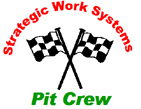Getting Fast, Focused, Sustainable Result
In an equipment-intensive operation, reliable equipment is the key to competitiveness. Throughput is highest, and costs are lower on all fronts: utilities, labor, overtime, repair parts and supplies, raw materials, and finished products. Reliable equipment performs as intended—the first time, every time at the lowest possible cost. The problem is that many companies and plants overlook what it takes to make equipment reliable. And because they are often “resource constrained,” they tend to be more reactive in their maintenance work than they truly want to be. Reliable equipment comes from a purposeful focus on three elements of productivity (people, work processes, and equipment) and from recognizing that most of the causes of poor equipment performance are outside the direct control of the maintainers (schedules, waiting, setups, startups, repair parts, operating efficiencies, quality, and yield losses).
First, the equipment data tells us the nature and extent of the performance and reliability problems. And equipment data comes from three different sources:
- The performance numbers (spreadsheets & charts: production, quality, maintenance, cost, etc.)
- The people closest to the equipment (operators and maintainers)
- Direct observation (go look at it)
Second, people have to turn that data into information, prioritize it, then turn it into reliable, consistent actions.
Third, work processes define what people must do to prevent and eliminate equipment problems—step-by-step procedures, methods, SOPs, detailed job plans. These work processes also form the basis for “best practices” or standardized work and for training, which in turn leads to the elimination of equipment problems.
The problem is that many people in industry today are not formally trained to follow a proven work process to perform critical tasks correctly the first time, every time. In small- to mid-sized operations, more than 80% of maintenance personnel have not been formally trained to do the tasks they are performing every day.1 If they are trained, they might not be held accountable for doing things the right way. Unfortunately, many well-meaning leaders in today’s plants assume that their people have all the right skills and knowledge to properly perform the assigned work. But the biggest variable in equipment performance and reliability is human induced failures—each person, each crew doing critical tasks however they please.
So what is the secret of generating revenue and lowering operating costs fast? Focus, focus, focus! Focus your reliability efforts on the critical few pieces of equipment in your production process flow. Look for the constraints first. This will lead to improved throughput and revenues. If the causes are related to equipment performance and reliability, then follow this simple process:
- Gather data to define the problem(s): type, frequency, duration, reasons, effects of, etc.
- Prioritize the impacts of the list of problems: downtime, costs, delays, rework, etc.
- Identify the possible causes of the biggest recurring preventable problem (focusing on one at a time.)
- Define possible solutions to the big problem (operations, maintenance, parts, training, modifications…).
- Try one of the possible solutions and measure the results:
- If it works, standardize the new work processes.\
- If it did not work, go back to step 3.
- Standardize the proven work process (“best practice”). Train everyone involved.
- Hold people accountable for using the new work process. Measure the results.
- Improve the work process, if needed, with a consensus from those performing the work. Measure the results.
- Go back to step 2. Pick another big problem and follow the remaining steps.
Sound familiar? It should. This is the same basic process used in the Toyota Production System (Rules in use #1 and #4) (See HBR, Bowen & Spears 2), in Lean Manufacturing (eliminate waste), in Six Sigma (DMAIC), Deming’s “plan, do, check, act,” in Total Productive Maintenance (5 basic pillars), the Scientific Method, and NASCAR’s top race teams. History shows us that these methods work fast. Why not follow the proven models and focus on results? Beware of shortcuts. Reliable equipment comes from reliable proven methods. Try it!
References:
- Over three years of anecdotal evidence from the author’s conference, seminar, and workshop participants
- Harvard Business Review, Sept-Oct 1999. Decoding the DNA of the Toyota Production System; Bowen and Spears.
© 2006
Robert M. Williamson
Strategic Work Systems, Inc.
Columbus, NC 28722
[email protected]
![]() Download a PDF of this article by clicking here Equipment reliability
Download a PDF of this article by clicking here Equipment reliability
